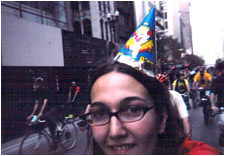I rode on the rides between January 2002 and August 2002,
and videotaped the April through June rides. While at these
rides, I asked and recorded 20 participants responses to
questions. Questions were formed to uncover why people ride
in the mass, who rides, what effects the ride has had on individual’s everyday
transportation experiences and what their ideal vision of
the city looks like. Check out the edited videos
to see the mass in movement and to hear the voices of mass
participants.
what effects the ride has had on individual’s everyday
transportation experiences and what their ideal vision of
the city looks like. Check out the edited videos
to see the mass in movement and to hear the voices of mass
participants.
This ethnographic analysis of Chicago's
Critical Mass is based on formal and informal interviews,
discussions on the CCM list-serve and conversations at unofficial
CM gatherings including the CCM happy hour. These observations
are supplemented by the CM unofficial web-pages, various
pamphlets and flyers disseminated at the rides and several
recently published books including edited volume of CM participants
Critical Mass: Bicycling’s Defiant Celebration
(Carlson, 2002) and Sociologist Jeff Ferrell’s Tearing
Down the Streets: Adventures in Urban Anarchism (2001).
I also examined maps of the city’s transportation
system and an analyzed how city and federal policy treats
biking as a viable mode of transportation. Because of the
experiential importance of the actual event, this thesis
would not have been possible without going on the rides.
I attempted to capture the key moments
of rides including: the circling of the Picasso in Daley
Plaza, rushing into the street in mass, rounding corners,
passing through and corking major or symbolic intersections.
I video-taped the bike-rides, by hand-holding the camera
while riding my bike in the Mass. I attached a basket with
my camera bag to the front of my bike and was generally
able to brake left handed with the small camera in my hand.
(I only flew over the handlebars once--the camera and I
were fine). I would often ride ahead of the mass, stop and
tape from the street and sidewalk. These vantage points
provide the perspectives of both the rider, as well as passers-by.
I documented the location of where I was shooting at intersections
by speaking the name of the streets, so I could reference
the video to the city space in the multi-media presentation.
However, I could not plan ahead of the Mass where to set
up cameras because the route is chosen at the event itself.
Also, rides are often ‘hijacked,” meaning the
route is not followed.
I also mapped the April-June rides onto
the City’s 2001 bike map and compared the actual routes
on official representations of space with proposed routes
on maps designed by Massers (see “The
Rides”). Mass participant Corey Conn used a Global
Positioning System unit to track the route taken on the
hijacked June ride. I used his data to plot the real route
of the June ride. The real routes of the April and May rides
are based on route maps handed out at the ride. These routes
were followed.
The field of ethnography is dominated
by textual interpretations of reality -- often accompanied
by a series of tables and photographs. Text, tables and
still photos cannot account for many important cultural
processes or cultural meanings—particularly those
of spatial interest. I argue that digital based multimedia
can be used as an analytical tool, enhancing our understanding
of some of the cultural forms of meaning that are not conveyable
in texts. These include movement, sound, technological processes,
and aesthetics. Multimedia facilitates the smooth juxtaposition
of many voices, providing deeper contextual information
and levels of abstraction to ethnography.
Critical Mass is an ideal socio-cultural
movement for a multi-media based analysis because of the
aesthetic appeal that draws people to the ride time and
time again. By using the layering capabilities of web, video
technology and graphic imaging, I juxtapose maps of the
city along with Mass-ride routes and city planning maps
to explore the construction of city space and the transformation
of the city image through the Critical Mass movement across
city streets. The juxtaposition of planned representations
of space and video highlight how the meaning of that space
is inverted during the rides and illustrates the powerful
and festive feelings individuals experience while riding
in Mass through spaces constructed not for bicycles but
for individual automobiles. This form of representation
provides a compressed argumentative image that synthesizes
planned images of the city space with the experienced empowerment
of transforming the use of that space during a social demonstration.



